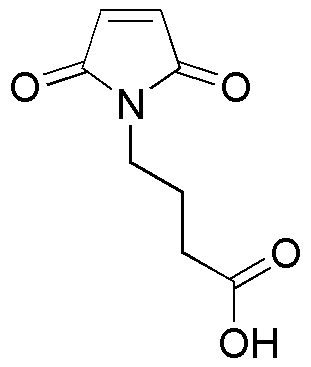N-(3-Carboxypropyl)maleimide is widely utilized in research focused on:
- Bioconjugation: This compound is valuable for attaching biomolecules, such as proteins or peptides, to surfaces or other molecules, enhancing the development of targeted drug delivery systems.
- Polymer Chemistry: It serves as a building block in the synthesis of functional polymers, which are used in coatings, adhesives, and sealants, offering improved durability and performance.
- Diagnostic Applications: The compound is employed in the creation of biosensors, which can detect specific biological markers, aiding in early disease diagnosis and monitoring.
- Pharmaceutical Development: It plays a role in the formulation of new therapeutics, particularly in the design of prodrugs that enhance bioavailability and reduce side effects.
- Material Science: N-(3-Carboxypropyl)maleimide is used to modify surfaces for better adhesion and compatibility in various materials, including plastics and composites, leading to improved product performance.
General Information
Properties
Safety and Regulations
Applications
N-(3-Carboxypropyl)maleimide is widely utilized in research focused on:
- Bioconjugation: This compound is valuable for attaching biomolecules, such as proteins or peptides, to surfaces or other molecules, enhancing the development of targeted drug delivery systems.
- Polymer Chemistry: It serves as a building block in the synthesis of functional polymers, which are used in coatings, adhesives, and sealants, offering improved durability and performance.
- Diagnostic Applications: The compound is employed in the creation of biosensors, which can detect specific biological markers, aiding in early disease diagnosis and monitoring.
- Pharmaceutical Development: It plays a role in the formulation of new therapeutics, particularly in the design of prodrugs that enhance bioavailability and reduce side effects.
- Material Science: N-(3-Carboxypropyl)maleimide is used to modify surfaces for better adhesion and compatibility in various materials, including plastics and composites, leading to improved product performance.
Documents
Safety Data Sheets (SDS)
The SDS provides comprehensive safety information on handling, storage, and disposal of the product.
Product Specification (PS)
The PS provides a comprehensive breakdown of the product’s properties, including chemical composition, physical state, purity, and storage requirements. It also details acceptable quality ranges and the product's intended applications.
Certificates of Analysis (COA)
Search for Certificates of Analysis (COA) by entering the products Lot Number. Lot and Batch Numbers can be found on a product’s label following the words ‘Lot’ or ‘Batch’.
*Catalog Number
*Lot Number
Certificates Of Origin (COO)
This COO confirms the country where the product was manufactured, and also details the materials and components used in it and whether it is derived from natural, synthetic, or other specific sources. This certificate may be required for customs, trade, and regulatory compliance.
*Catalog Number
*Lot Number
Safety Data Sheets (SDS)
The SDS provides comprehensive safety information on handling, storage, and disposal of the product.
DownloadProduct Specification (PS)
The PS provides a comprehensive breakdown of the product’s properties, including chemical composition, physical state, purity, and storage requirements. It also details acceptable quality ranges and the product's intended applications.
DownloadCertificates of Analysis (COA)
Search for Certificates of Analysis (COA) by entering the products Lot Number. Lot and Batch Numbers can be found on a product’s label following the words ‘Lot’ or ‘Batch’.
*Catalog Number
*Lot Number
Certificates Of Origin (COO)
This COO confirms the country where the product was manufactured, and also details the materials and components used in it and whether it is derived from natural, synthetic, or other specific sources. This certificate may be required for customs, trade, and regulatory compliance.


